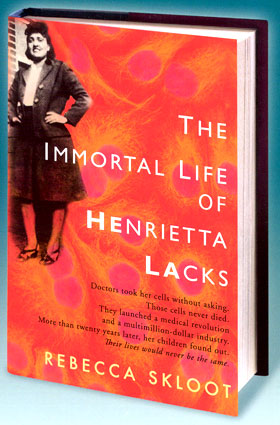Medical researchers use laboratory-grown human cells to learn the intricacies of how cells work and test theories about the causes and treatment of diseases. The cell lines they need are immortal they can grow indefinitely, be frozen for decades, divided into different batches and shared among scientists. : There are only about 10 popular cell lines used today in cell biology research and one of the most commonly used is the HeLa cell line.
The story behind HeLa cells (pic1, pic2), an immortal cell line, which has been at the foundation of countless biomedical breakthroughs and discoveries in cell and molecular biology, has been documented by Rebecca� Skloot, the author of a new book The Immortal Life of Henrietta Lacks. The story of Henrietta lacks was also captured on film ("Colored Bodies") by Charlene Gilbert.
Henrietta Lacks, the daughter of poor Virginia tobacco farmers, died of cervical cancer in the "colored" ward of Johns Hopkins Hospital in the middle of an October night in 1951. Only about 30 years old when she died, Lacks left behind five children, a husband, and several extended family members. Her doctors at Johns Hopkins took a tissue sample of her tumor without telling her and sent it down the hall to scientists there who had been trying to grow tissues in culture for decades without success. � Back then, no human cells had ever been cultured in the lab and survived. Lack's cells were different. Much to the surprise of the doctors (George & Margaret Gey of Johns Hopkins University) who collected the cells from Lacks, the sample of the cancerous cervical cells that killed her grew and flourished in culture, sometimes taking over entire petri dishes. They continue growing today and it is estimated that as much as 50 million metric tons have been grown in culture worldwide. Labs all over the world depend upon them as vital tools in their search for anti-cancer compounds and knowledge about oncology and cell function. Hela cells have been used in an estimated 60,000 scientific studies. HeLa cells were essential in developing the polio vaccine. HeLa cells went up in the early space missions to see what would happen to cells in zero gravity. Many scientific landmarks have used her cells, including cloning, gene mapping and in vitro fertilization. [see a graphic of results obtained from HeLa cell studies.] next back

The ethics of growing human cells in the labaoratory was a serious issue in the 1950s, so Henrietta Lacks' cells were given the code name HeLa, for the first two letters in her name. Today, anonymizing samples is a very important part of doing research on cells. When members of the press got close to finding Henrietta’s family, the Gey's who’d grown the cells made up a pseudonym—Helen Lane—to throw the media off track. Other pseudonyms, like Helen Larsen, eventually showed up, too. Her real name didn’t really leak out into the world until the 1970s.
Henrietta Lacks was not informed that her tissues would be used in research, and the scientific community essentially ignored that fact for decades. HeLa cells were the first human biological materials ever bought and sold, which helped launch a multi-billion-dollar industry. Online, you can go and buy HeLa cells or products developed using HeLa cells for anywhere from a hundred dollars to around $10,000 per vial. While HeLa cells have enriched the lives of those who sold them the Lack's children and grandchildren, who never recieved a penny of compensation, have struggled. Henrietta's daughter, Deborah, has said... "Truth be told, I can't get Mad at science, because it helped people live". But, "I would like some health insurance so I don't got to pay all that money every month for drugs my mother cells probably helped make."
When Henrietta's sons found out years later that people were selling vials of their mother’s cells, and that the family didn’t get any of the resulting money, they got very angry. Henrietta’s family has lived in poverty most of their lives, and many of them can’t afford health insurance. One of her sons was homeless and living on the streets of Baltimore. Her family has a really hard time affording health insurance, and that makes them very angry. So the family launched a campaign to get some of what they felt they were owed financially. It many ways it has consumed their lives.
So much of science today revolves around using human biological tissue of some kind. For scientists, cells are often just like tubes or fruit flies—they’re just inanimate tools that are always there in the lab. The people behind those samples often have their own thoughts and feelings about what should happen to their tissues, but they’re usually left out of the equation.
Resources:
The Immortal Life of Henrietta Lacks, by Rebecca Skloot, Crown Pub., NY, 2010. 368 pp. ISBN: 978-1-4000-5217-2. $26.00.
http://www.smithsonianmag.com/science-nature/Henrietta-Lacks-Immortal-Cells.html